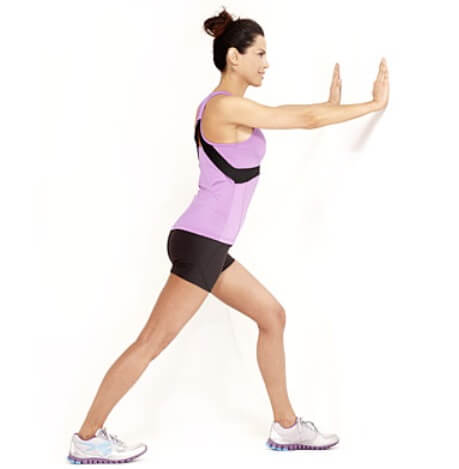Our leg burden a lot more pressure while standing or performing any activity than we can imagine, so the amount of tension in the lower leg requires us to pay more attention to the causes that lead to tight calf muscles, and different ways to stretch them.
The calf structure consist of two muscles: the gastrocnemius and the lower muscle are solitary. Both muscles are positioned in the lower leg at the back of the ankle and in the Achilles tendon. The calf is a very powerful plantar muscle due to the configuration of the ankle and the relatively long lever arm.
The length of the gastrocnemius muscle extends from just above the knee up to above the heels, so the knee must be fully extended to extend this muscle. The solitary muscle is rooted in the gastrocnemius muscle and originates below the knee so that the soleus is not reached.
In this article we will focus on Tight Calf Muscles, their causes and their importance by showing you different exercises that will help you loosen tighten.
Causes of Tight Calf Muscles
The most common way in which the calf becomes too tight is by lack of ankle movement to enable dorsal flexibility of the calf. If you can’t flex your foot (pull your toes toward you), you won’t feel that the calf muscle is there, because the lack of movement in the ankle restricts it.
If not handled regularly to extend its full range of motion, the calf muscle becomes tight. It will also keep our calves short for longer periods of time if we wear high heels shoes. When the muscles are compressed, they will eventually shorten to fit the new length, that lead disproportionate to their normal length.
The calf is a postural muscle. To keep us upright, the calf must contract for long periods without tiring. So therefore, it can be tightened quickly.
An athletes calf muscles are strengthened if there is a full session of stretching during training.
For some people, tight calves may be caused by hereditary factors.
How to Fix Tight Calves
An excellent way to start is to first make sure that you have adequate mobility on your knee. Tight calves can be loosened by extending and massaging the muscles and using tools such as a foam roller or massage ball to release the myofascial.
The first step is to release the myophastic calves so that tight trigger points can be removed. The tight calf is not enough to fix it by its own, because other muscles need opposite pressure to release completely. The fascia is a plate of connective tissue that stabilizes and separates muscles, bones, and organs from others.
They hug your bones too tightly when your calves are tight. The fascia around the calf can release it and return to its normal state of separation from the bones, when sufficient pressure is placed on the calf muscles.
If your tool, such as a foam roller or massage ball, is used to loosen the bone grip, the fascia can act as a lubricant for the calf muscles. One of the best ways to get rid of a calf strain is to stretch the tight calf muscle.
Why Stretching Tight Calf Muscles is Essential?
Stretching improves the flexibility of the calf muscles, which helps you increase your range of motion. Moreover, lengthening tight calves by applying constantly contraction on them.
It also increases blood circulation to the calf muscles and connective tissues in the ankle joints by bringing in fresh blood. This enhances the cure and improves the health of your calves.
When you perform stretching exercises regularly, this helps ensure that you don’t lose your limited range of motion or flexibility, and you’ll avoid tightening your calf muscles once you’ve loosen them out.
To move properly and run properly, it is necessary to maintain the lengthening of the calf muscles. You must be able to raise your foot to a certain height to properly stretch the muscles. In other joints such as move the foot or the knee forward, if the ankle cannot go as far within natural limits, compensatory movements must be performed. This can cause the toe out, excessive pronation of the forefoot, overwhelming reverse back, and excessive rotation of the knee, etc.
Due of these compensatory movements, injuries, tendinitis, fasciitis, and joint degeneration can occur. If restricted mobility occured for these cases, participation in the operation may be required.
Flexibility in the calf muscle is imperative for any sport that takes a long time to perform, such as long walking, running or jumping.
The Importance of Calf Health
Healthy calfs give you better shape, more strength and faster efficiency over the time while you exercise. On the other hand, weak calves often lead to the most common running issues: achilles tendonitis, shin splints, calf muscle tension, hamstring or hip problems and even plantar fasciitis.
Since your calf plays such a significant role in running mechanics, it needs a lot of maintenance, and you should lengthen your muscles regularly and perform Calf Exercises every while.
Tight Calf for a variety of foot and ankle problems are a vital part of the rehabilitation process. Density in the calf can influence the foot position, movement, and balance. Foot pain and knee pain are one of common causes.
The calf is made up of two muscles that work in conjunction with the toes. Their primary job is to elevate the foot during the push-off phase, which means that most athletes who ride bikes and runners have the most calf problems.
Calf stretching exercises help reduce pain, strain, and instability. Therefore, the risk of injury or disease such as Achilles tendonitis, plantar fasciitis and cramp is reduced.
You can stretch a tight calf and relieve the associated pain with a combination of flexibility and regular veal massage.
On article, we starts with the gastrocnemius and soleus muscle, the calf muscle, and how it works here. We will then see how we can stretch each and how we can get the best results with the least amount of stretching effort possible.
Calf lengthening is necessary in order for your legs, hips, and hamstrings to be stronger and less injured.
Stretching Tight Calf Muscles
When you don’t move your leg in a regular motion every once in a while, your calf becomes tight over time. For example, if you sit at a desk without walking around, you will remain in one position on your knee and your joints, which will become weak and exposed to any future injuries.
Regular stretching can help if you find your calves to be tight. Try to perform the following exercises every day to keep your calf muscles stretched and flexible. It makes muscle fibers lengthen and may reduce pain.
Here are the most effective exercises for tight calf muscles. These exercises will surely provide relief to your tight leg. Let’s take an overview of how it performs!
-
Wall Calf Stretch
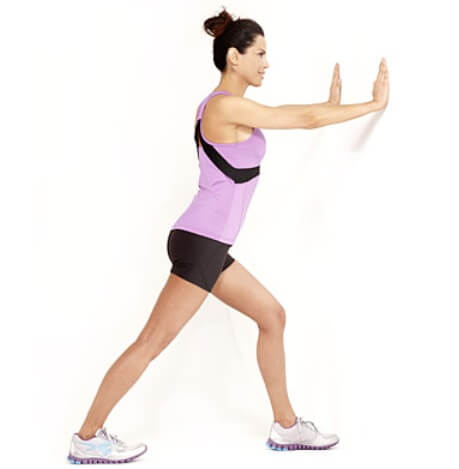
Stand at arm’s length from the wall. Put your left leg forward, your palms against the wall at shoulder level, then send your right leg back. Bend your left knee and press into your right heel while keeping your feet flat on the floor and your back straight.
Push your chest toward the wall with the distance of one hand.
Hold this position for 20-30 seconds, then bring your chest back, then continue like this. When the repetitions are over, move and switch to the other side of the leg and start the exercise.
-
Wall Curb Stretch
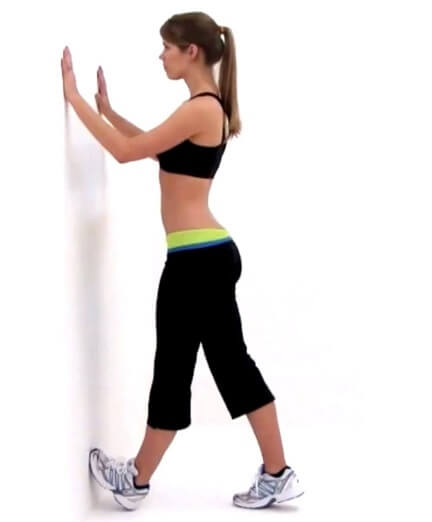
Stand a few inches from a wall while your palms touching it. Place the toes of your left foot against the wall keeping the heels on the floor, and send your right leg back. Bend your left foot against the wall and press gently for 15-20 seconds. Then go to the other side and repeat.
-
Seated Calf Stretch with Band
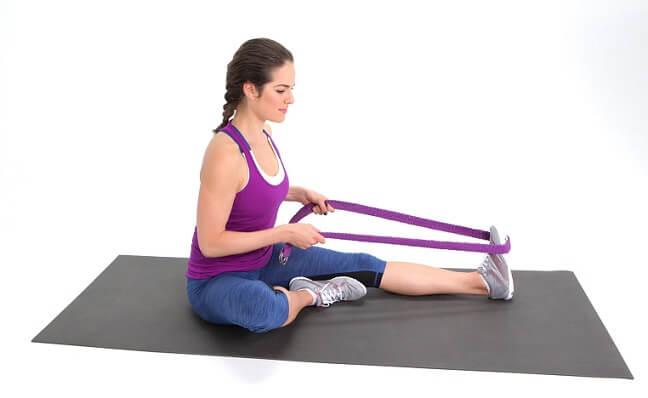
Sit comfortably on the floor, or on a pillow if your legs are too tight and feel uncomfortable so your spine stays straight. Bend your right leg inward, so your right feet towards your left thighs, and fully extend the left leg.
Wrap your left foot on the legs ball with a yoga bracelet or loop band (or an old tie or a bathrobe belt). Hold both ends of the laces to pull the band toward your torso while keeping your left heel fixed to the floor. Hold the pulling gently for 30 to 40 seconds, then repeat by switching to the other leg side.
-
Downward Facing Dog Stretch
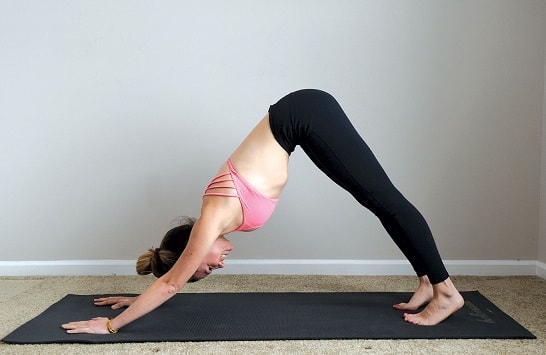
It is one of the classic yoga poses, in which it is necessary to press the calf towards the floor.
Start by sitting on all fours, then place and press your palms to the floor, gradually raising your hips toward the ceiling, keeping your toes flat on the floor, so eventually your body is in a V-shape.
Begin gently pressing your heels so that they touch the floor. The closer your foot heels is to the ground, the deeper your calf will stretches.
Bend your knees slightly as you push your heels toward the floor to extend the lower of your calves. Stay in this position for 1 minute, then rest and repeat 3-4 times.
-
Stretching Tight calf muscle using a Foam roller
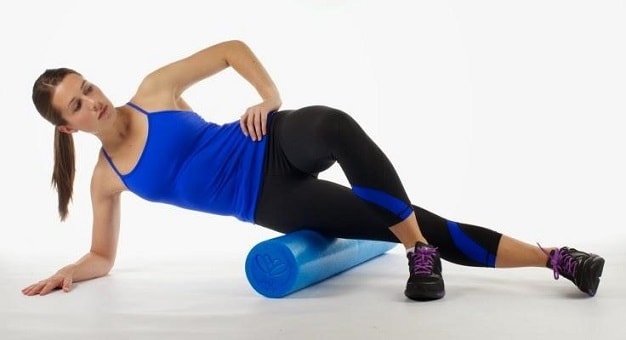
Sit on the ground. Place the foam roller under the side of the right leg at a level just below your knees. Lift and cross your right leg over your left leg, then place your right foot on the ground. Put your left forearm on the floor to lift your body up off the ground, and begin to roll the foam back and forth by pushing with your right foot.
Slowly roll your calf muscle to about knee level above the foam and roll back up to your heels, then repeat. Do not cross the knee level while rolling. Do this with your toes pointing out.
-
Calf and Shoulder Stretching
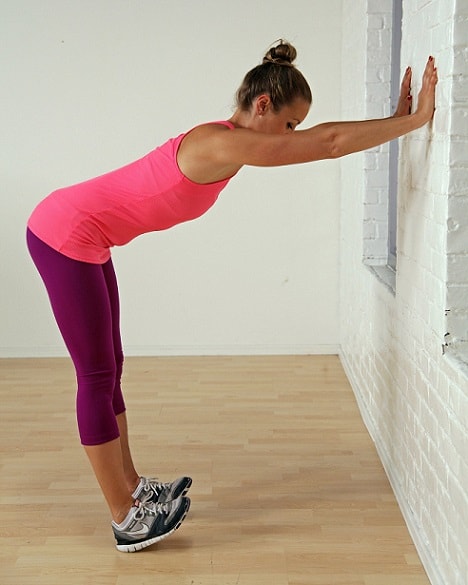
Stand with your feet toward the wall. Place your palms on the wall, and keep your hands shoulder width apart. Without locking your knees, while balancing your heights, lift your toes off the floor and send your butt back as far as you can, while support your body balance using your heels.
Hold this position for thirty seconds, then return your toes to the floor.
Final Words
All these above-mentioned stretches are capable enough to cure your tight calf muscle pain.
But remember, when stretching the calf muscles, you should only feel a slight tightening. If you feel severe pain or discomfort, stop exercising and visit doctor to find out the cause of the real pain, it could be something other than just tight muscles.
Calf muscles can be safely stretched several times a day. Whenever you feel a calf tight, quickly stretch it to keep it loose and flexible. The best practice for its use is when stretching the calf muscles and Achilles tendons.
To get relief from severe pain, you should get proper treatment from a specialist.

